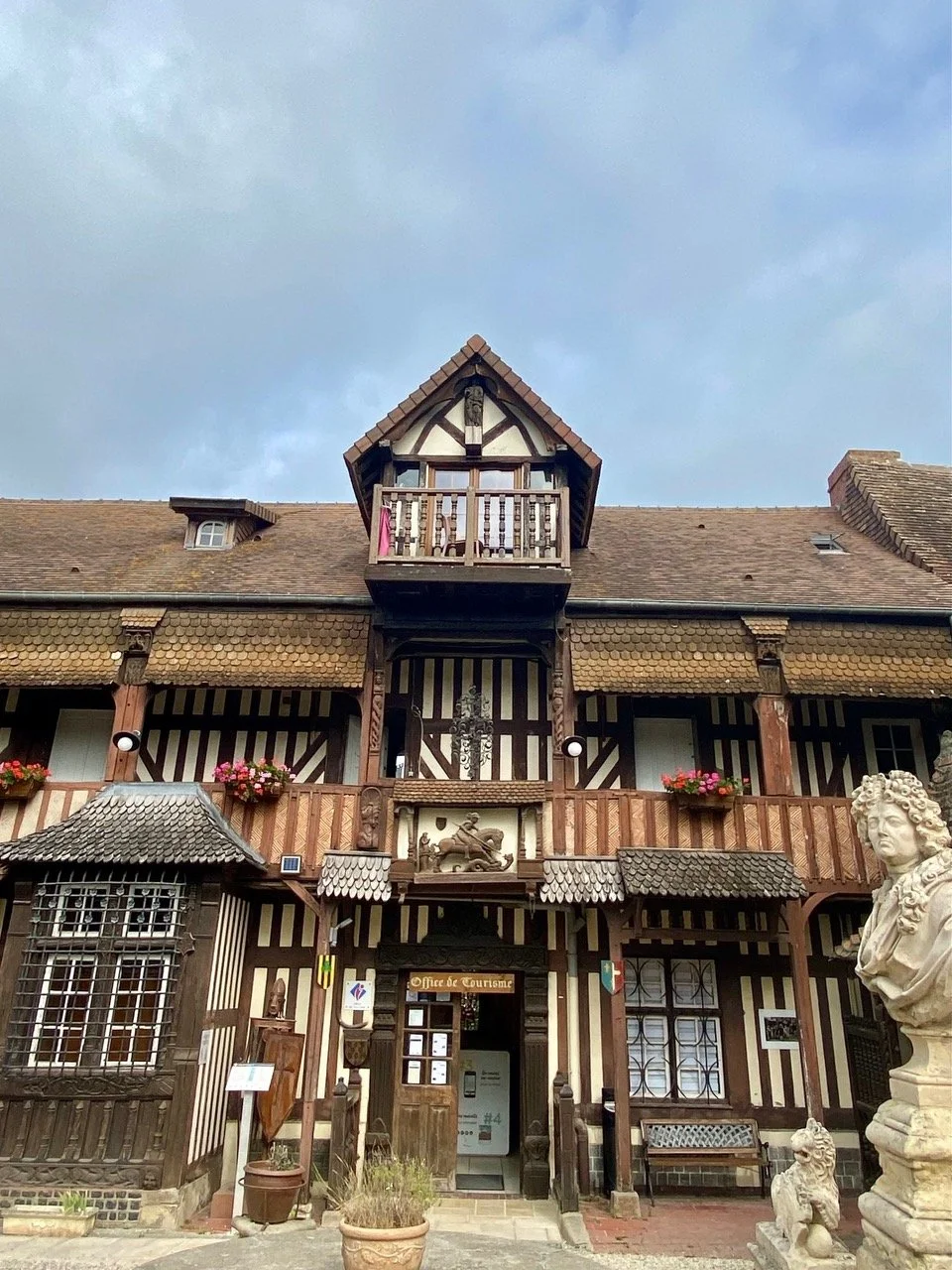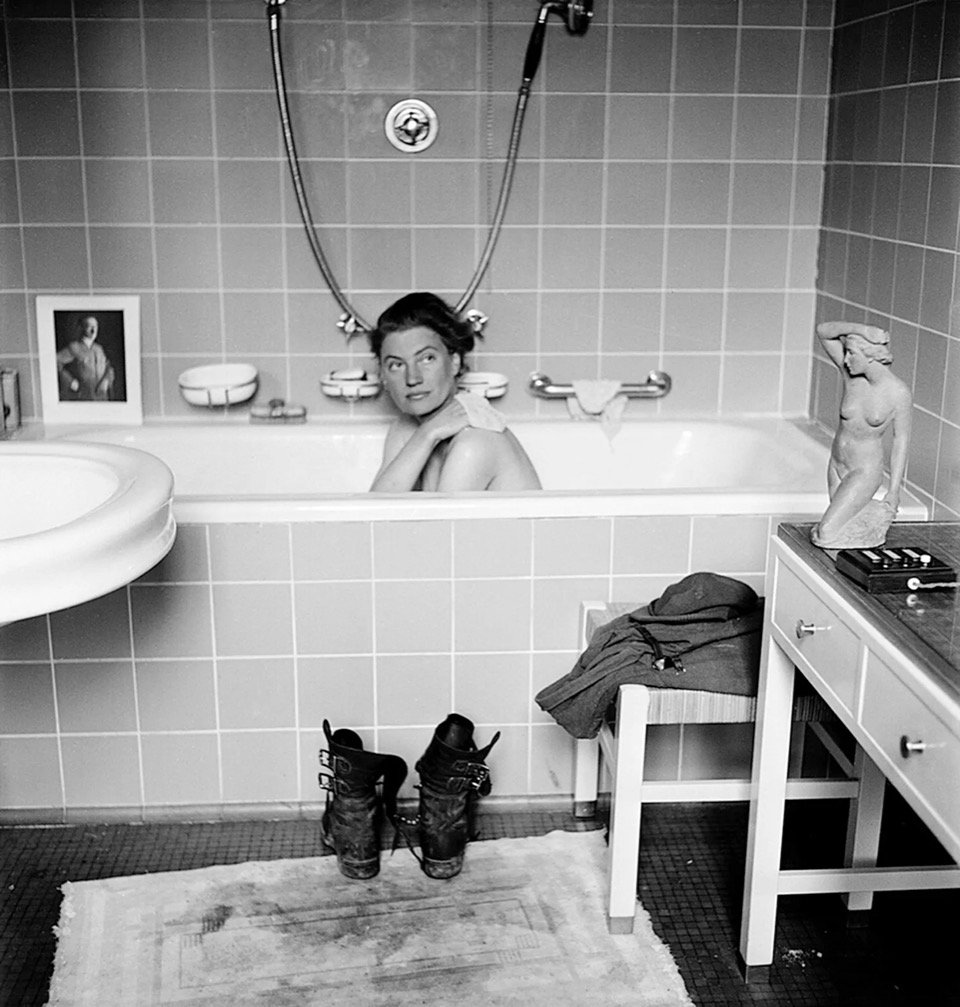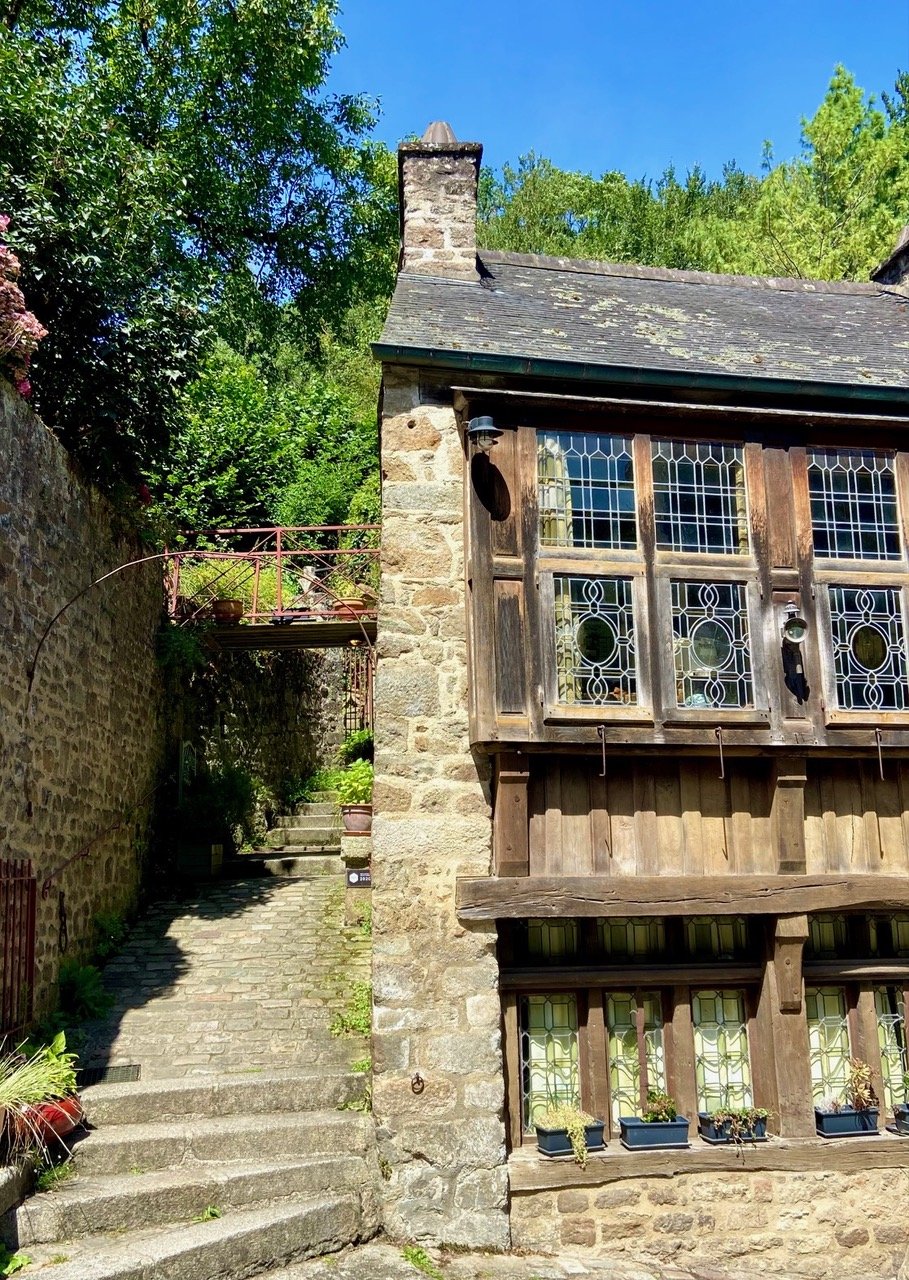Normandie on my mind (and Bretagne, too)
Newsletter 08.25.2024
'Red sky (sun) at night, sailor’s delight. Red sky (sun) in morning, sailor’s warning' This is the Sky at Sunset in Houlgate
Bienvenue and welcome back to Musée Musings your idiosyncratic guide to Paris and art. This week finds me once again singing the praises of Dives-sur-Mer and Normandie and trying to sound positive about Brittany, too. I really understand why Parisians have ‘maisons secondaire’ in Normandy. It’s a quick trip and if the beach isn’t your thing - there are lots of towns with art museums & restaurants to visit.
The house where I stayed was so peaceful. There were fences on two sides heavy laden with blooming flowers. Gardens at the back and front enhanced the sense of privacy. But as soon as I walked out the front gate, I was on rue Hastings - named after the battle and not Poirot’s sidekick (Major Hastings)! That battle, as you’ll remember from your visit to the Bayeux Museum, was fought on 14 October 1066 and was the decisive event in the conquest of England by the Duke of Normandy aka Guillaume le Conquerant. (Fig 1)
Figure 1. Bayeux Tapestry depicting the conquest of England by William the Conqueror
The village of Dives is charming, with boulangeries, patisseries, fromageries and a grand covered marché that spills into the nearby streets on Saturdays. (Figs 2-5)
Figure 2. Village des Arts, Dives-sur-Mer
Figure 3. Covered Market, Dives-sur-Mer
Figure 4. Fromagerie Coeur d’Artichaut, Dives-sur-Mer
Figure 5. One of four boulangeries in Dives, I fell for this huge brioche and it took me a week to eat it, ech
After Whistler and Hockney in Rouen on Saturday and a fabulous lunch at Pavé d’Auge in nearby Beuvron and the daredevil air show above the Cabourg beach on Sunday, I was eager to see what the rest of the week would bring. (Au Revoir Paris Olympics)
La Villa du Temps retrouvé in Cabourg was open on Monday, so that’s where I walked. (Fig 6) I grew up in a city and I have always lived in a city. What I don’t like about the countryside is that if I want to go anywhere, I have to drive. Walking in the countryside should be fun but somehow I always seem to meet up with unleashed shepherd dogs who want to shepherd me, aka bite at my ankles. Not cool!
Figure 6. La Villa du Temps retrouvé, Cabourg
So I was happy to walk along a beautiful beach, to a ….museum! And en route to while away an hour at a little café just a few steps from the Grand Hotel and all of its colorful changing tents. (Figs 7 - 9)
Figure 7. Me on the beach between Dives-sur-Mer and Cabourg
Figure 8. Changing tents on the beach in front of the Grand Hotel, Cabourg
Figure 9. Changing tents from The Grand Hotel, Cabourg
I had already been to La Villa du Temps retrouvé twice this year. Once in February when it was closed and then again as the last stop on my press trip from hell in March - when I was too sick to enjoy it. This time was different. It looked good, I felt good. There was a lot of Proust, of course, I’ll tell you about that when I tell you about the Whistler exhibition. And when I show you the two books I bought on my last day in Dives. It was drizzling when I walked over to check out the Fete de la Mer at the port at Dives. I wandered while I watched and listened to bagpipe players, (Figs 10, 11). When it really started to rain, I sought shelter at a little covered stall, filled with illustrated books. Books about Proust! I bought two of them. (Fig 12)
Figure 10. Fete de la Mer, Dives-sur-Mer
Figure 11. Bagpipe players at Fete de la Mer, Dives-sur-Mer
Figure 12. Proust books I bought at the Fete de la Mer, Dives-sur-Mer
At the La Villa du Temps retrouvé, in addition to the Proust stuff, there was an exhibition about Jules Verne. (Fig 13) I’m not a science fiction fan, history and reality are enough (sometimes too much) for me! The exhibition on Verne fits with the Villa’s focus which is the Belle Epoque. The period during which Marcel Proust lived and wrote. The years between the end of the Franco-Prussian War and the beginning of World War I (1871-1914). Which is also when Verne wrote and set his bestselling adventure novels, Journey to the Center of the Earth, Twenty Thousand Leagues Under the Seas, and Around the World in Eighty Days.
Figure 13. Jules Verne at La Villa du Temps retrouvé
To write his books, Verne drew upon the latest scientific knowledge of his time and incorporated the most sophisticated technological advances. In addition to immersing his readers in Belle Époque inventions, Verne imagined a future that he and his readers could only dream of, some of which we, living nearly a century later, are experiencing, for better and worse.
The exhibition was lively and visually engaging with historical objects and plans and models. (Figs 14, 15) Since one of the Villa’s goals is to appeal to families, the exhibition designers “created bridges” between the Belle Epoque and our contemporary world, through films, video games and music, to show how Verne’s ideas continue to resonate with our imaginations today.
Figure 14. Jules Verne exhibition, La Villa du Temps retrouvé
Figure 15. Model of Nautilus, Jules Verne Exhibition, La Villa du Temps retrouvé
I will have to admit that years can and have gone by without me thinking about about Jules Verne. And yet, he showed up again a week later! The second time was when I got to Brittany, to St Malo. At the Chapelle Saint-Sauveur I saw a temporary exhibition entitled, ‘Explorer des pôles aux profondeurs.’ The exhibition focused mostly on Jean-Baptiste Charcot (Figs 16 - 18) who first explored Antartica in 1903 in a boat built in St Malo. Charcot was an olympic medalist (silver in sailing, 1900 Paris Olympics) and a medical doctor. His first boat was called Le Français, his second boat, Pourquoi-Pas? It was on the Pourquoi Pas? that he died, still exploring at age 69, the victim, with many of his crew, of a violent cyclonic storm.
Figure 16. Jean-Baptiste Charcot, Explorer des pôles aux profondeurs, St. Malo
Figure 17. Pourquoi Pas? Charcot’s boat, 1908-1936, Explorer des pôles aux profondeurs, St. Malo
Figure 18. Model of a Diving Bell, Explorer des pôles aux profondeurs, St. Malo
Along with lots of ‘real’ stuff about exploration - from Charcot’s time through our own, there were references to Jules Verne and his writings about the exploration of the poles and the ocean’s depths (Fig 19). I wonder if this is just the beginning, and as with Proust, I will be running into references to Jules Verne everywhere from now on!
Figure 19. Twenty Thousand Leagues under the Sea, Jules Verne Explorer des pôles aux profondeurs, St. Malo
Let’s see, what else. In June of this year, Emanuel Macron and Joe Biden attended ceremonies marking the 80th anniversary of the Normandy landings. I wasn’t planning to visit Omaha Beach or the American Cemetery, but I did. I began thinking seriously about going after I saw an exhibition at the recently repurposed former nunnery, the Franciscaines, in Deauville. The exhibition was about Robert Capa and included the 11 images he took on D-Day, 6 June 1944. (Figs 20, 21) The images are not clear and are surrounded by controversy because Capa claimed to have shot over 200 photos of which only 11 survived. Eventually it became clear that Capa, who landed with the third wave of soldiers, without a weapon or military protection, got out as quickly as he could and didn’t really take 200 photos.
Figure 20. American Troops Landing at Omaha Beach, June, 1944, Robert Capa, Icônes, Franciscaines, Deauville
Figure 21. American Troops Landing at Omaha Beach, 6 June, 1944, Robert Capa, Icônes, Franciscaines, Deauville
I wasn’t sure what to expect at the American Cemetery, I read some questions people had posed online, among them, could they visit ‘Obama’ Beach and was there anywhere to have a picnic at the cemetery. The day I visited, the sky was a crystal clear blue and so was the water - they met seamlessly at the horizon. (Figs 22-26) The day of the landing was cold and overcast, the water frigid and turbulent. The seasick soldiers, with heavy packs on their backs were easy targets for German machine guns and American pilot errors. And very quickly, the blood of these young, untried men, turned the choppy sea red.
Figure 22. Reflecting Pool, American Cemetery, Colleville-sur-Mer, France
Figure 23. Spirit of American Youth Rising from the Waves, American Cemetery, Colleville-sur-Mer, France
Figure 24.
Spirit of American Youth Rising from the Waves,
American Cemetery, Colleville-sur-Mer, France, detail
Figure 25. Graves of fallen soldiers, American Cemetery, Colleville-sur-Mer, France
Figure 26. The graves of fallen soldiers, American Cemetery, Colleville-sur-Mer, France
I saw a second exhibition in St Malo, also at a de-sanctified church, also about World War II. The subject of this one was the liberation of St Malo in August 1944 and the photographer who documented it, Lee Miller. (Fig 27) I have written about Miller in conjunction with the surrealist artist Man Ray and her wartime photographs for Vogue Magazine. A well known photograph of her during the war shows her in Hitler’s bathtub. (Fig 28) But that one drop of humor was in an ocean of horror. She was one of only four accredited female photographers permitted to accompany US armed forces. She was with the American soldiers who liberated the Buchenwald concentration camp. By the 1950s, living in England and after suffering years of severe bouts of depression (PTSD), she put her photographs and camera into the attic and became a gourmet cook. It was only after her death that her son Antony Penrose found her war photographs.
Figure 27. Poster for exhibition of Lee Miller’s and Liberation of St. Malo, August 1944
Figure 28. Lee Miller in Hitler’s bathtub, photographed by David Scherman
The same day I visited the American cemetery, I continued on to Caen. To see an exhibition at the Beaux Arts Museum. The museum is in a chateau, where there is a restaurant for which a young chef is creating marvelous meals. I had a chance to chat with him after lunch, I’ll tell you about that in my round up of my favorite (and not so favorite) meals. The exhibition I came to see was about advertising. (Fig 29) The same subject of exhibitions at the Bibliothèque Forney and at the Musee des Arts Decoratifs. All of which also reference the Paris 1924 Olympics. I will tell you about them soon.
Figure 29. Le Spectacle de la Marchandise, Musée des Beaux Arts, Caen
Another surprise at the Museum in Caens is that their permanent collection includes a painting I know well, the Marriage of the Virgin by Raphael’s teacher, Perugino. (Fig 30) As luck would have it, I saw Raphael’s version of the same painting last year, at the Brera Gallery in Milan. (Figs 31, 32) Can you see the differences?
Figure 30. The Marriage of theVirgin, Perugino
Figure 31. Marriage of the Virgin, Raphael
Figure 32. Raphael (left) & Perugino (right) There are a lot of minor differences but one of the most obvious is the reaction of one of Mary’s suitors. In Perugino’s version, he bends his rod over his thigh, in Raphael’s version, he breaks his rod at his knee. The reason Mary chose Joseph, as you know was that his rod flowered (and was bigger, too!!)
There were some disappointments. Lunch at the Ferme Saint Simeon, which I had been so looking forward to, was expensive and unexceptional. The Boudin Museum in nearby Honfleur was so hot that I had to abandon trying to see the temporary exhibition which was so poorly presented that I don’t think I missed much.
The other disappointment fits into the category of ‘I should have known better.’ I fled the anticipated crowds in Paris only to find them waiting for me at Mont Saint Michel. The signage for getting to the church was confusing, the press of people was suffocating. Some things are best seen from a distance, Mont Saint Michel is certainly one of them. If you do go, go off season as my friend Melinda did and wander around the village when it is empty. Or just admire the church from afar. (Figs 33, 34)
Figure 33. Mont St. Michel. from below, from a distance on a beautiful day in August
Figure 34. Cloister, Mont St. Michel - cloisters are enclosed, this one is in the sky, there’s glass so you don’t fall out
Let’s see, what else. I remember reading about and looking at photographs of Christian Dior’s childhood home in Granville when I visited the Dior Museum in Paris. I didn’t know where Granville was and I didn’t imagine that I would ever visit it. And yet there I was, en route from Normandie to Bretagne stopping at Granville to admire the garden, have lunch in the outdoor cafe and visit the museum. A completely unexpected pleasure. (Figs 35-37)
Figure 35. Christian Dior’s childhood home, Granville. Garden of Five Senses
Figure 36. View from Granville
Figure 37. One of the many iconic Dior dresses on display in Granville
I will not tell you about the place I stayed in the suburbs of St Malo because it was so awful. Not the house per se which was without any interest inside or out, but the sticks of vanilla that I rounded up after waking up the first morning with a terrible migraine. That was followed by the constant smell of petrol that emanated from the basement, which the vanilla sticks had masked but which a closed basement door and opened windows throughout the house couldn’t eliminate. I left early and was back in Paris in time to watch the closing ceremonies of the Olympics.
I did visit St. Malo a few times (Figs 38-40). I walked along the beach and enjoyed the two exhibitions I mentioned above. Staying so far from St. Malo turned out not to be a problem. Since parking inside the town’s walls is so limited and spaces fill so early, the city has found an alternative. And that is parking at the train station outside of town. The price for all day parking is a little more than 3 euros. And with the parking ticket as proof that your car is at the train station, you can ride the city bus, for free, from the train station to St Malo and back. Easy, inexpensive and no stress.
Figure 38. St Malo, another gorgeous beach
Figure 39. St Malo walking to Ft Vauban at low tide
Figure 40. St Malo, The walk to Ft. Vauban, good preparation for the Camino
When I was in St Malo a few years ago, I visited Cancale and nearby Dinars. This time I spent a day in Dinan. After a lovely lunch in a delightful garden, I found a sweet little art museum nestled above the port. (Figs 41-43)
Figure 41. Dinan, Street performer
Figure 42. Dinan, on my way to the
Musée Yvonne Jean-Haffen
Figure 43. Dinans, The
Musée Yvonne Jean-Haffen sits high above the port
Post Script: Many of you agreed that the Olympics are probably not the best place for basketball legends to make their mark. Here’s some additional information. The elimination games were played in Lille. The basketball players didn’t want to stay in Lille. So they stayed in Paris and took a chartered train to Lille when they had to be there. During the Olympics themselves, the basketball players stayed in a 5 star hotel rather than at the Olympic Village. Actually, the NBA took over an 800 room, 5 star Paris hotel in which the players, coaches and anyone affiliated with the team, including families and friends, stayed. The cost? $15 million. How exactly does that sort of self segregation promote friendships across borders? Ginevra reminds me that the most important thing for a good performance is a good night’s sleep. Probably easier in a 5 star hotel room than in the un air conditioned Olympic village where so many of the athletes bought little fans from the supermarket and mattress toppers from IKEA. And so it goes. Gros bisous, Dr. B.
Thanks so much to those of you who sent Comments, they are much, much appreciated.
New comments on Au revoir Paris Olympics, Bonjour Normandie :
I miss the olympics....it was mesmerizing..LA has a very hard act to follow. Paris did a spectacular job right through to the closing ceremony. I could have done without the Tom Cruise part but I assume that was a US add -on. You picture of the air show are wonderful....any pictures of the treacherous bridge?....trembling just thinking about that! Can't wait to hear more about Normandie trip. Shirley
Thank you for sharing your thoughts. Loved your critique of the Olympics. There has been much discussion over the years about professionals. I tend to favor all the athlete being amateurs. That being said, you must admit that women's basketball and soccer were exciting to watch. Ben, Baltimore
Nice review of the closing ceremonies. Did you attend in person or view on a large screen TV at a bistro? Ah yes, your two week sojourn to other areas of France made for an enchanting tale. Envy your selection of exhibits and concise review. Bill, Columbus, OH











































